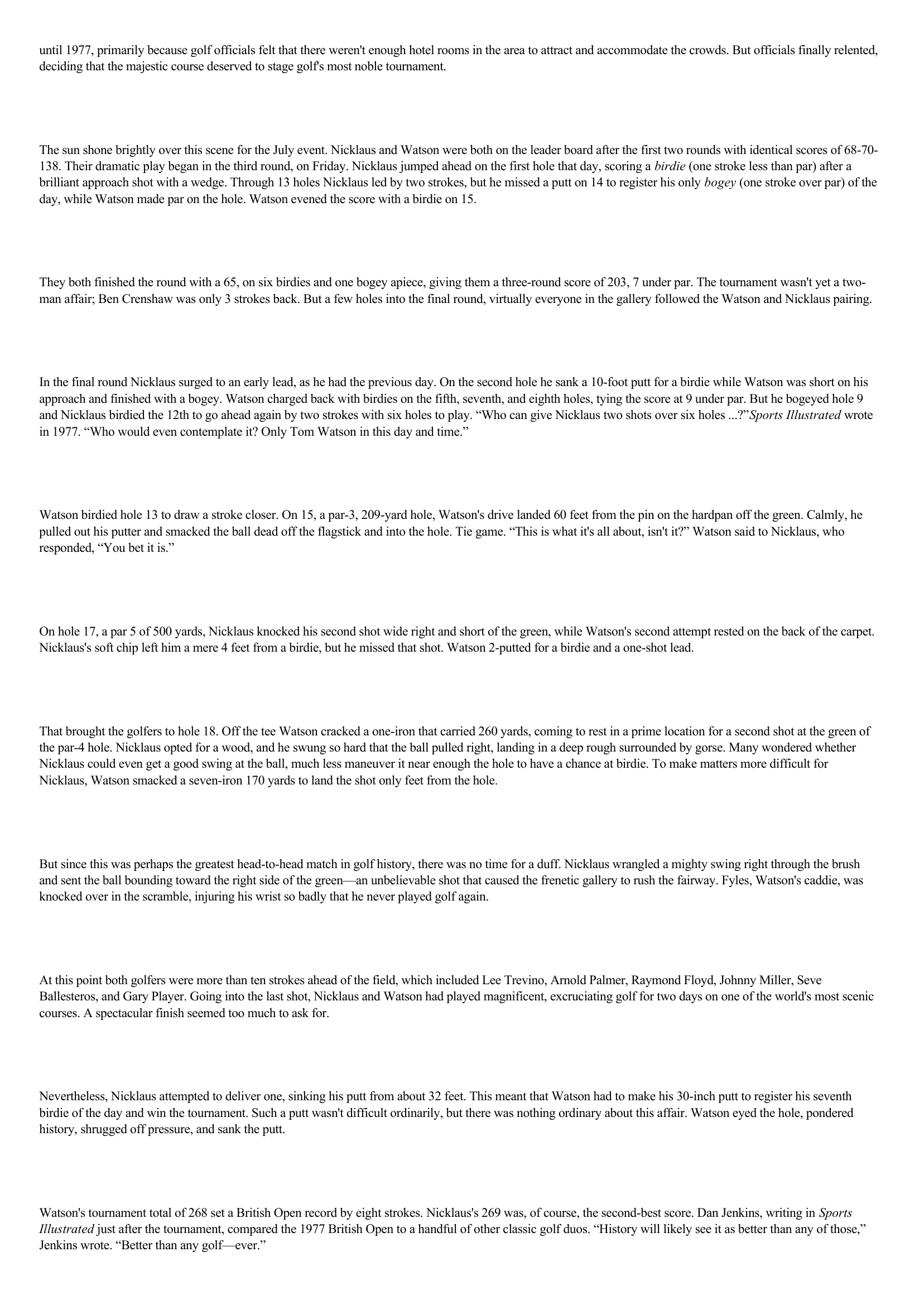Nicklaus-Watson Match.
Publié le 14/05/2013

Extrait du document
«
until 1977, primarily because golf officials felt that there weren't enough hotel rooms in the area to attract and accommodate the crowds.
But officials finally relented,deciding that the majestic course deserved to stage golf's most noble tournament.
The sun shone brightly over this scene for the July event.
Nicklaus and Watson were both on the leader board after the first two rounds with identical scores of 68-70-138.
Their dramatic play began in the third round, on Friday.
Nicklaus jumped ahead on the first hole that day, scoring a birdie (one stroke less than par) after a brilliant approach shot with a wedge.
Through 13 holes Nicklaus led by two strokes, but he missed a putt on 14 to register his only bogey (one stroke over par) of the day, while Watson made par on the hole.
Watson evened the score with a birdie on 15.
They both finished the round with a 65, on six birdies and one bogey apiece, giving them a three-round score of 203, 7 under par.
The tournament wasn't yet a two-man affair; Ben Crenshaw was only 3 strokes back.
But a few holes into the final round, virtually everyone in the gallery followed the Watson and Nicklaus pairing.
In the final round Nicklaus surged to an early lead, as he had the previous day.
On the second hole he sank a 10-foot putt for a birdie while Watson was short on hisapproach and finished with a bogey.
Watson charged back with birdies on the fifth, seventh, and eighth holes, tying the score at 9 under par.
But he bogeyed hole 9and Nicklaus birdied the 12th to go ahead again by two strokes with six holes to play.
“Who can give Nicklaus two shots over six holes ...?” Sports Illustrated wrote in 1977.
“Who would even contemplate it? Only Tom Watson in this day and time.”
Watson birdied hole 13 to draw a stroke closer.
On 15, a par-3, 209-yard hole, Watson's drive landed 60 feet from the pin on the hardpan off the green.
Calmly, hepulled out his putter and smacked the ball dead off the flagstick and into the hole.
Tie game.
“This is what it's all about, isn't it?” Watson said to Nicklaus, whoresponded, “You bet it is.”
On hole 17, a par 5 of 500 yards, Nicklaus knocked his second shot wide right and short of the green, while Watson's second attempt rested on the back of the carpet.Nicklaus's soft chip left him a mere 4 feet from a birdie, but he missed that shot.
Watson 2-putted for a birdie and a one-shot lead.
That brought the golfers to hole 18.
Off the tee Watson cracked a one-iron that carried 260 yards, coming to rest in a prime location for a second shot at the green ofthe par-4 hole.
Nicklaus opted for a wood, and he swung so hard that the ball pulled right, landing in a deep rough surrounded by gorse.
Many wondered whetherNicklaus could even get a good swing at the ball, much less maneuver it near enough the hole to have a chance at birdie.
To make matters more difficult forNicklaus, Watson smacked a seven-iron 170 yards to land the shot only feet from the hole.
But since this was perhaps the greatest head-to-head match in golf history, there was no time for a duff.
Nicklaus wrangled a mighty swing right through the brushand sent the ball bounding toward the right side of the green—an unbelievable shot that caused the frenetic gallery to rush the fairway.
Fyles, Watson's caddie, wasknocked over in the scramble, injuring his wrist so badly that he never played golf again.
At this point both golfers were more than ten strokes ahead of the field, which included Lee Trevino, Arnold Palmer, Raymond Floyd, Johnny Miller, SeveBallesteros, and Gary Player.
Going into the last shot, Nicklaus and Watson had played magnificent, excruciating golf for two days on one of the world's most sceniccourses.
A spectacular finish seemed too much to ask for.
Nevertheless, Nicklaus attempted to deliver one, sinking his putt from about 32 feet.
This meant that Watson had to make his 30-inch putt to register his seventhbirdie of the day and win the tournament.
Such a putt wasn't difficult ordinarily, but there was nothing ordinary about this affair.
Watson eyed the hole, ponderedhistory, shrugged off pressure, and sank the putt.
Watson's tournament total of 268 set a British Open record by eight strokes.
Nicklaus's 269 was, of course, the second-best score.
Dan Jenkins, writing in Sports Illustrated just after the tournament, compared the 1977 British Open to a handful of other classic golf duos.
“History will likely see it as better than any of those,” Jenkins wrote.
“Better than any golf—ever.”.
»
↓↓↓ APERÇU DU DOCUMENT ↓↓↓
Liens utiles
- Watson, John Broadus - psychologie & psychanalyse.
- PSYCHOLOGIE DU COMPORTEMENT (LA), John Broadus Watson (résumé)
- FOOTBALL a match two teams playing against each other in a 90-minute game of football a pitch the area where footballers play a match a referee the person who makes sure that the players follow the rules.
- Watson John Broadus, 1878-1958, né à Greenville (Caroline du Sud), psychologue américain.
- Watson T om , né en 1949 à Kansas City, joueur de golf américain.










